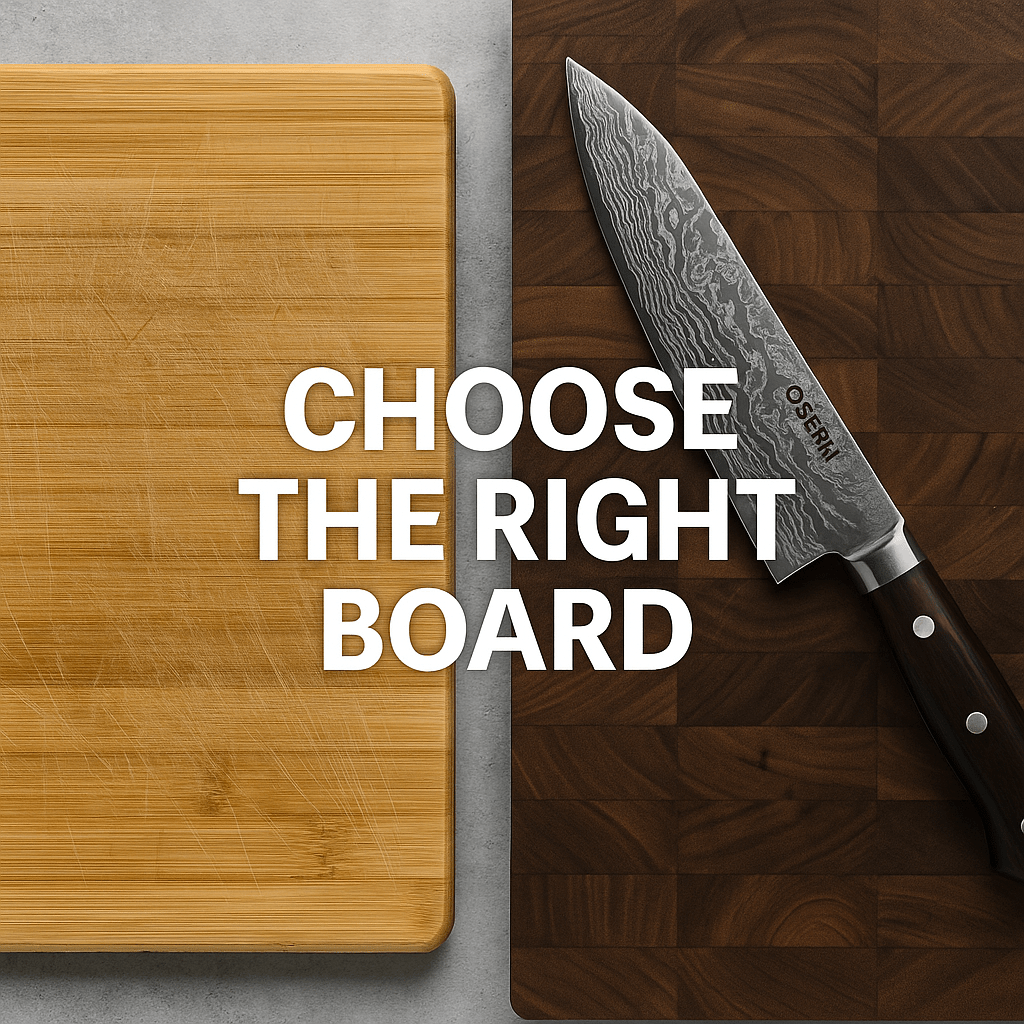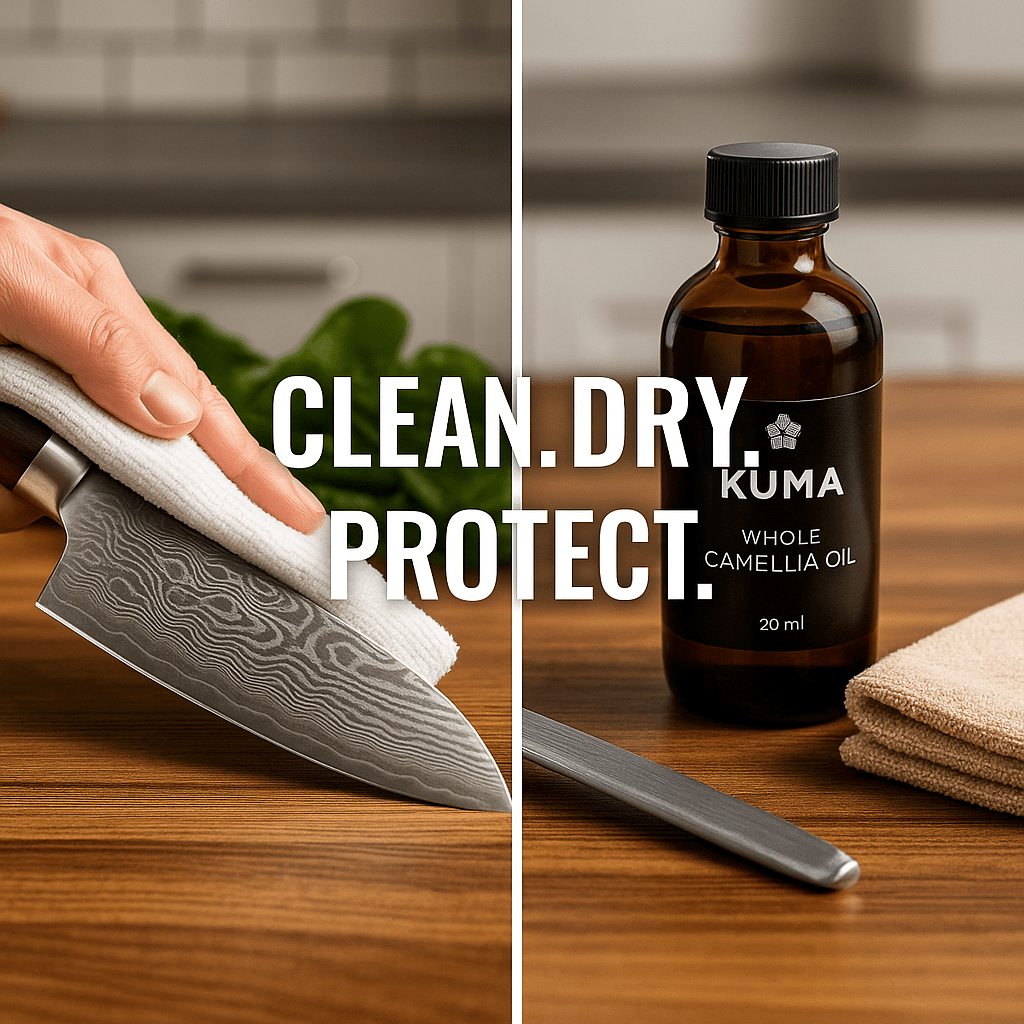
Can You Use a Japanese Knife on Any Cutting Board?
Japanese knives, especially OSERM’s Damascus and VG-10 steel series, are crafted for ultimate precision — razor-thin edges designed to glide through food effortlessly. However, even the sharpest knife can dull or chip prematurely if paired with the wrong cutting board. In this article, we’ll explore which cutting boards protect your blades and which ones silently destroy them.
1. The Hidden Relationship Between Blade and Board
Every cut creates microscopic friction between your knife and the surface beneath. Harder cutting boards can damage fine edges, while softer boards absorb the impact. Japanese knives, with their ultra-fine edges (typically 15° per side), demand the right surface to maintain their legendary sharpness.
So, no — not all cutting boards are suitable for Japanese knives. Choosing the right one directly affects both performance and longevity.
2. The Best Cutting Boards for Japanese Knives
✅ Wooden End-Grain Boards (Recommended)
End-grain wood boards, made from premium walnut, cherry, or maple, are the gold standard. The fibers run vertically, allowing the blade to slide between them — a natural cushioning effect that minimizes wear. They also resist bacteria and self-heal small cuts over time.
- ✅ Gentle on knife edges
- ✅ Long lifespan with proper oiling
- ✅ Naturally beautiful and durable
OSERM Recommendation: Walnut or acacia end-grain board — the perfect companion for Damascus blades.
✅ Softwood Boards (Hinoki Cypress)
Used traditionally in Japan, Hinoki cypress boards are soft, fragrant, and ideal for delicate Japanese blades. They offer excellent shock absorption and preserve the fine geometry of your Gyuto, Santoku, and Nakiri knives.
- ✅ Excellent shock absorption
- ✅ Naturally antibacterial
- ✅ Lightweight and easy to handle
3. The Cutting Boards to Avoid
❌ Glass and Marble Boards
These are absolute edge-killers. While they may look elegant, they’re far too hard for knife use. A single chop can cause microchips along a Damascus edge, ruining your blade’s polish and sharpness permanently.
Verdict: Never use glass, ceramic, or stone boards — even for temporary use.
❌ Hard Plastic (Polycarbonate or Acrylic)
Plastic boards are affordable and easy to sanitize, but most are too rigid. Over time, the knife’s edge wears down quickly. Worse yet, plastic boards can warp, creating uneven cutting surfaces that increase the risk of slipping and injury.
- ⚠️ Acceptable only as temporary or backup boards
- ⚠️ Avoid for high-end Japanese knives
❌ Bamboo Boards
Bamboo is often marketed as eco-friendly, but it’s deceptively hard and filled with adhesive glue that dulls edges rapidly. While durable, it’s not suitable for precision blades.
4. Proper Cutting Board Maintenance
Even the best cutting board won’t protect your knife if it’s poorly maintained. Dryness, warping, and food residue can increase friction and trap moisture that damages your blades.
How to Maintain Wooden Boards:
- After washing, dry completely with a soft towel.
- Apply food-safe mineral oil once a week to keep the surface hydrated.
- Use a separate board for raw meat to prevent contamination.
- Never submerge in water or place in the dishwasher.
5. What OSERM Recommends
Our Damascus knives are designed for maximum sharpness and elegance, but they perform best when paired with soft or end-grain wooden cutting boards. These surfaces mirror the respect that Japanese craftsmanship deserves — soft to the blade yet strong in durability.
By combining an OSERM Damascus knife with a premium end-grain board, you’re not just extending the life of your knife — you’re protecting your investment in true culinary artistry.
6. Common Mistakes Home Cooks Make
- Using marble or granite boards for aesthetics.
- Cutting acidic fruits (like lemons) and leaving residue on wooden boards without cleaning.
- Skipping oiling, leading to cracking or splintering.
- Using one board for everything — mixing raw meat and vegetables.
Conclusion
Japanese knives are masterpieces — but even masterpieces need the right canvas. The board you choose matters just as much as the blade you hold. Opt for a warm, wooden surface that cushions every slice and honors the craftsmanship within your OSERM knife.
Because when precision meets the perfect surface, every cut becomes effortless art.
Weekly Deal 🔥
Pair your OSERM Damascus knives with our Premium Walnut End-Grain Cutting Board — gentle on edges, naturally antibacterial, and a perfect visual match for your Damascus collection.
You Might Also Like
- Wood vs Plastic Cutting Boards – Which Protects Knives Better?
- Knife Care 101 – How to Make Your Knives Last Longer
- How to Clean Your Damascus Knives – Do’s and Don’ts
Tags: OSERM Damascus knives, Japanese knife care, cutting board guide, end-grain board, Hinoki board, knife maintenance, VG-10 steel, kitchen essentials






